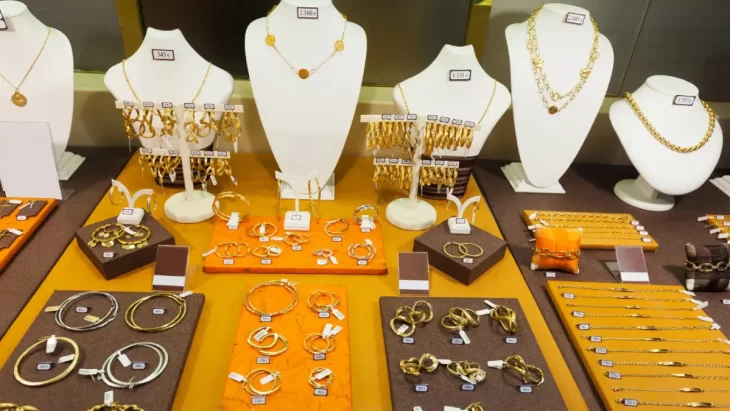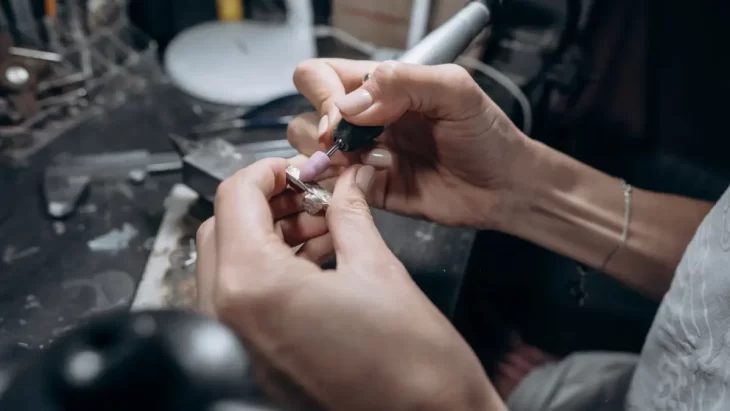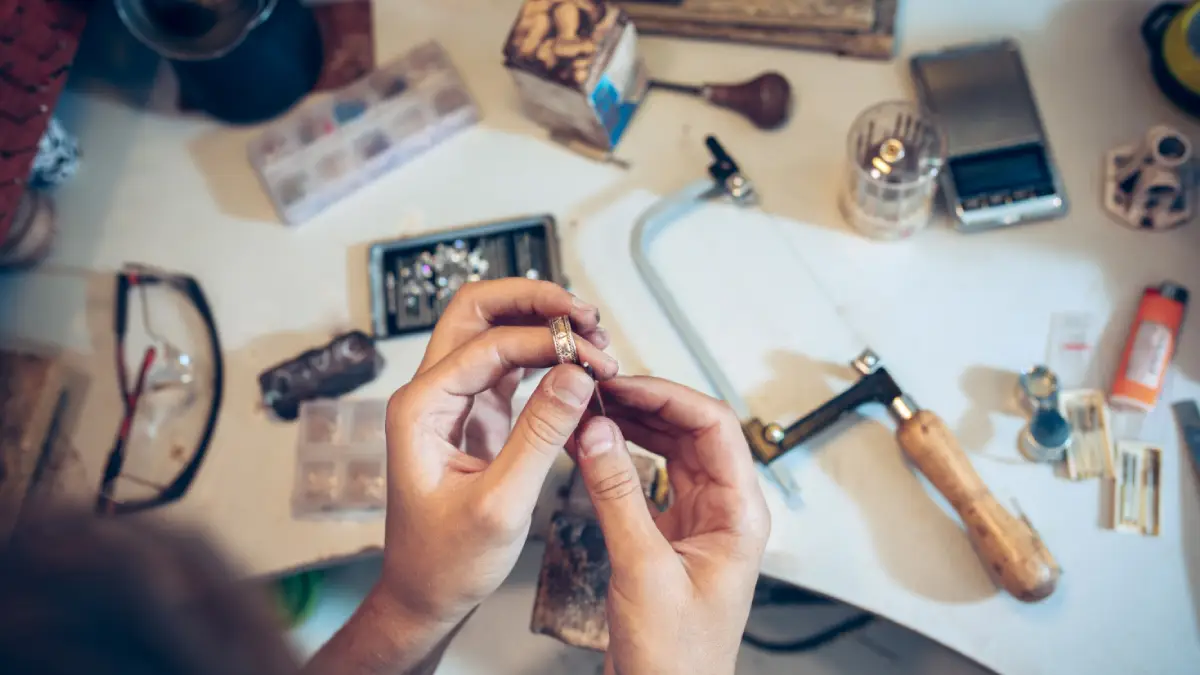Are you ready to turn your passion for jewelry into a thriving business venture? Delve into the fascinating world of permanent jewelry with us and learn how to start a permanent jewelry business that sparkles with success.
In a realm where artistry meets entrepreneurship, this guide will be your North Star.
If you’ve ever dreamt of creating exquisite jewelry that captivates hearts, you’re in the right place.
Unearth the secrets to crafting stunning jewelry, honing your design skills, and navigating the intricate market with confidence.
By the end of this journey, you’ll be poised to shine in the world of permanent jewelry, drawing admirers and loyal customers.
Let’s embark on this creative voyage, where your passion for jewelry transforms into a lucrative, lasting business.
How to Start a Permanent Jewelry Business: A Comprehensive Guide

Starting your own permanent jewelry business is an exciting venture, and with the right knowledge and planning, it can become a successful endeavor.
This comprehensive guide will walk you through the essential steps to launch your jewelry business, from research and planning to creative design and sourcing materials.
By the end of this article, you’ll have a clear roadmap to kickstart your jewelry business with confidence and success.
Research and Planning
Market Research: Identifying Your Niche
- Understand Your Market: Begin by thoroughly researching the jewelry industry. Know the trends, demographics, and consumer preferences. This will help you identify gaps and opportunities.
- Define Your Niche: Narrow down your focus. Determine the type of jewelry you want to create. Consider factors like style, materials, and target audience.
Competitor Analysis: Learning from the Best
- Study Your Competitors: Analyze successful jewelry businesses in your niche. Learn from their strategies, understand their strengths and weaknesses, and identify areas where you can stand out.
Crafting a Unique Selling Proposition (USP)
- What Sets You Apart: Identify what makes your jewelry business unique. Is it your design style, materials, or customer service? Your USP will set you apart from the competition.
Creating a Business Plan for Your Jewelry Venture
- The Roadmap to Success: Develop a comprehensive business plan. It should outline your business goals, financial projections, marketing strategies, and operational details.
Legal and Financial Considerations
Choosing a Business Structure
- Legal Foundation: Decide on a suitable legal structure for your business, such as a sole proprietorship, LLC, or corporation. Each has its own implications for taxes, liability, and management.
Registering Your Jewelry Business
- Official Recognition: Register your business with the necessary authorities. This step is essential for compliance and building trust with your customers.
Setting Up a Separate Business Bank Account
- Financial Separation: Open a separate bank account for your business. This ensures your personal and business finances are distinct, simplifying record-keeping.
Budgeting and Financial Forecasting
- Financial Planning: Create a budget and financial forecast. It will help you manage your finances, set pricing, and make informed decisions as your business grows.
Sourcing Materials and Supplies
Finding Reliable Jewelry Suppliers
- Source Wisely: Identify dependable suppliers for your materials and tools. Reliability is key to maintaining consistent quality.
Selecting High-Quality Materials
- Quality Matters: Ensure you use high-quality materials for your jewelry. Quality will set you apart and build trust with your customers.
Managing Your Inventory Efficiently
- Inventory Control: Implement efficient inventory management systems to prevent overstocking or running out of crucial materials.
Establishing Vendor Relationships
- Build Partnerships: Nurture relationships with your suppliers. Good rapport can lead to better terms and reliable access to materials.
Design and Creativity
Developing Your Jewelry Design Style
- Find Your Signature: Discover and develop your unique design style. This is what will make your jewelry stand out.
Sketching and Prototyping Your Creations
- Bring Ideas to Life: Sketch your designs and create prototypes. This step ensures your vision translates into tangible pieces.
The Importance of Staying on-Trend
- Stay Current: Keep an eye on fashion and jewelry trends. Adapting to the latest styles keeps your offerings relevant.
Balancing Creativity with Market Demand
- Market Sensibility: While being creative is essential, it’s equally important to align your creations with what your target audience desires.
Starting a permanent jewelry business is a journey that requires dedication and a well-thought-out plan.
By carefully considering each step, you’ll be on the path to creating beautiful, unique pieces that customers will adore.
Your commitment to research, quality, and creativity will set the foundation for a thriving jewelry business. So, roll up your sleeves and get ready to embark on this exciting venture!
Crafting Your Brand Identity

Your brand identity is the face of your permanent jewelry business. It’s what sets you apart and leaves a lasting impression on your customers. Let’s delve into the crucial aspects of shaping your brand identity.
Choosing a Memorable Business Name
- Reflect Your Essence: Your business name should encapsulate your vision, style, or specialty.
- Check Availability: Ensure the name isn’t already in use and secure the relevant domain name.
Designing a Captivating Logo
- Visual Identity: A well-designed logo is the visual cornerstone of your brand.
- Professional Help: Consider hiring a graphic designer for a polished logo.
Crafting a Compelling Brand Story
- Connect with Customers: Share your journey, inspiration, and the passion behind your jewelry.
- Human Touch: Make it relatable; people love to connect with the story behind the brand.
Building an Online and Offline Presence
- Website: Create an SEO-optimized website to reach a wider audience.
- Local Presence: Participate in craft fairs, and trade shows, or have a physical store if viable.
Creating a Jewelry Workshop
Your workspace is where your jewelry dreams come to life. Let’s explore the essentials of creating an efficient jewelry workshop.
Setting Up a Well-Equipped Workspace
- Proper Lighting: Ensure good lighting for detailed work.
- Organized Layout: Have dedicated spaces for different tasks like designing, crafting, and packaging.
Investing in Essential Tools and Equipment
- Quality Over Quantity: Invest in high-quality tools that will last and perform well.
- Safety Gear: Always prioritize safety; use goggles and gloves when needed.
Ensuring Safety and Compliance
- Local Regulations: Be aware of local safety and business regulations.
- Ventilation: Adequate ventilation is crucial when working with certain materials.
Organizing Your Workflow
- Efficiency: Plan your work process, from design to finishing, to maximize productivity.
- Inventory Management: Keep track of materials and tools to avoid delays.
Jewelry Making Techniques

Mastering the art of jewelry making is at the core of your business. Let’s delve into the skills you need to succeed.
Mastering Basic Jewelry-Making Techniques
- Start Simple: Begin with basic techniques like stringing, wirework, and beading.
- Practice: Mastery comes with practice, so create sample pieces to hone your skills.
Learning Advanced Skills and Craftsmanship
- Progress Gradually: Once you’re comfortable with the basics, explore more advanced techniques like soldering or stone setting.
- Courses and Workshops: Consider taking specialized courses to enhance your expertise.
Incorporating Gemology Knowledge
- Gem Selection: Learn to select and grade gemstones for quality and authenticity.
- Gem Trends: Stay updated on gemstone trends to offer what’s in demand.
Staying Up-to-Date with Evolving Trends
- Market Research: Continuously research current jewelry trends to adapt your designs.
- Innovate: Be open to new materials and styles; innovation keeps your brand fresh.
Marketing and Sales Strategies
Your beautiful jewelry deserves a spotlight. Here’s how to market and sell it effectively.
Building a Stunning Jewelry Portfolio
- Photography: Showcase your pieces with high-quality photos.
- Online Catalog: Create an online catalog for easy browsing.
Utilizing Social Media for Promotion
- Engagement: Interact with your audience on social media to build a following.
- Visual Content: Visual platforms like Instagram and Pinterest work exceptionally well for jewelry.
Creating an E-Commerce Website
- User-Friendly: Design a user-friendly website where customers can easily browse and purchase.
- Secure Payment: Ensure secure payment options to build trust.
Participating in Craft Shows and Fairs
- Local Exposure: Craft fairs provide local visibility and a chance to connect with customers.
- Inventory Planning: Prepare adequate stock and promotional materials for such events.
In the intricate world of the permanent jewelry business, your brand identity, workspace, skills, and marketing strategies will play pivotal roles in your journey to success.
Keep in mind the importance of a compelling story and online presence. So, let your creativity shine, and craft your brand into a name people remember.
Pricing and Profitability

Setting the right prices for your jewelry is crucial for the success and sustainability of your business. Here’s what you need to know about pricing and ensuring profitability.
Pricing Your Jewelry Pieces Competitively
- Market Research: Research similar jewelry pieces in your niche to understand their price range.
- Competitive Edge: Consider factors like quality, design, and brand reputation to price your pieces competitively.
- Value Perception: Ensure that your pricing reflects the value and quality of your jewelry.
Calculating the Cost of Goods Sold (COGS)
- Direct Costs: Identify all the direct costs involved in making each piece, including materials and labor.
- Indirect Costs: Don’t forget indirect costs like rent, utilities, and equipment maintenance.
- Accurate Tracking: Keep meticulous records of costs to calculate COGS accurately.
Understanding Profit Margins
- Gross Margin: Calculate your gross margin by subtracting COGS from your total revenue.
- Net Profit Margin: Deduct all business expenses, including marketing and administrative costs, to determine your net profit margin.
- Healthy Margins: Aim for healthy profit margins that allow for business growth and sustainability.
Implementing Effective Pricing Strategies
- Tiered Pricing: Offer a range of jewelry pieces at different price points to appeal to a broader customer base.
- Discounts and Promotions: Strategically use discounts and promotions to boost sales during certain periods.
- Monitor Competitors: Keep an eye on your competitors’ pricing strategies and adjust yours accordingly.
Customer Service and Relations

Exceptional customer service is a cornerstone of a successful jewelry business. It not only retains customers but also brings new ones. Let’s explore how to excel in this area.
Delivering Exceptional Customer Service
- Prompt Communication: Respond to customer inquiries and issues promptly.
- Personalized Service: Treat each customer with care and attention, making them feel valued.
- Problem Resolution: Address customer concerns and complaints professionally and swiftly.
Handling Inquiries, Orders, and Returns
- Order Processing: Streamline the ordering process on your website or in-store for a hassle-free experience.
- Clear Return Policy: Establish a clear return policy to handle returns and exchanges with transparency.
- Customer-Friendly Procedures: Make it easy for customers to get help or initiate returns.
Building Long-Lasting Customer Relationships
- Loyalty Programs: Consider loyalty programs or rewards to encourage repeat business.
- Regular Updates: Keep customers informed about new arrivals, promotions, and events through newsletters or social media.
- Thank You Gestures: Show appreciation by sending thank-you notes or small gifts with purchases.
Collecting and Using Customer Feedback
- Feedback Collection: Encourage customers to provide feedback on their experiences.
- Continuous Improvement: Use feedback to make improvements and enhance your offerings.
- Transparency: Let customers know how their feedback has led to positive changes.
Scaling and Growth

Expanding your jewelry business is an exciting step. Here’s how to plan for growth effectively.
Expanding Your Jewelry Business
- Market Expansion: Explore new geographical markets or demographics for your jewelry.
- Online Presence: Enhance your online presence to reach a broader audience.
- Collaborations: Consider collaborations with other brands or designers for mutual growth.
Hiring and Managing Employees
- Delegation: As your business grows, hire skilled employees to assist with tasks like production, marketing, or customer service.
- Training and Management: Invest in proper training and efficient management for your team.
- Work Culture: Foster a positive work culture that reflects your brand’s values.
Diversifying Your Product Offerings
- New Lines: Introduce new jewelry lines or complementary products to cater to different tastes.
- Limited Editions: Create limited edition pieces to generate excitement and urgency.
- Sustainability: Consider offering eco-friendly or ethical jewelry options to tap into the growing demand.
Exploring New Markets and Opportunities
- Market Trends: Stay informed about market trends and opportunities for growth.
- Networking: Attend industry events, and trade shows, and network with potential partners.
- Risk Management: Assess potential risks and challenges as you explore new opportunities.
Overcoming Challenges

Challenges are part of any business journey. Here’s how to address and overcome them in your permanent jewelry business.
Dealing with Competition and Market Saturation
- Niche Differentiation: Find a unique selling proposition that sets you apart from competitors.
- Continuous Innovation: Innovate and adapt to evolving customer preferences and trends.
- Customer Loyalty: Build strong customer relationships to retain a loyal customer base.
Managing Fluctuations in the Jewelry Market
- Diversification: Offer a variety of jewelry styles to mitigate the impact of market fluctuations.
- Market Analysis: Stay informed about market shifts and adapt your strategies accordingly.
- Resilience: Develop resilience to endure market downturns and recover effectively.
Coping with Creative Blocks and Burnout
- Mental Health: Prioritize self-care and seek inspiration outside of your work.
- Collaboration: Collaborate with other artists or designers to reignite your creativity.
- Take Breaks: Don’t be afraid to take breaks to recharge and avoid burnout.
Adapting to Changing Consumer Preferences
- Flexibility: Be open to adapting your designs and offerings to align with evolving preferences.
- Market Research: Continuously research and understand shifting consumer trends.
- Feedback Integration: Use customer feedback to guide adjustments to your jewelry designs.
In the dynamic world of a permanent jewelry business, mastering pricing, offering exceptional customer service, planning for growth, and tackling challenges are key factors in your path to success.
Stay adaptable, embrace change, and continue to provide quality and value to your customers.
Conclusion
In conclusion, embarking on the journey of starting a permanent jewelry business is both a creative and entrepreneurial endeavor.
Through the comprehensive guide provided, you have gained valuable insights into the intricacies of this industry.
From researching and planning to delivering exceptional customer service, this article has equipped you with the knowledge needed to thrive in the world of jewelry making.
Remember, pricing your jewelry competitively, understanding profitability, and continuously adapting to market trends is essential for long-term success.
Building lasting customer relationships, scaling your business, and overcoming challenges will be the pillars of your growth.
As you venture into this creative realm, keep in mind that the journey is as important as the destination, and each step you take is a valuable lesson.
Your jewelry business will not only be a source of income but a platform for self-expression and artistry. So, craft your brand, create stunning pieces, and nurture your passion.
As you do, your journey in the permanent jewelry business will be a rewarding and enriching one, offering not only beautiful jewelry but also a unique story to share with the world.
Best of luck on your creative and entrepreneurial path.
FAQ: How to Start a Permanent Jewelry Business
1. Is permanent jewelry profitable?
Permanent jewelry can be profitable, but success depends on factors like product quality, market demand, and effective pricing strategies. Conduct thorough research and plan your business well for better profitability.
2. What does it cost to start a permanent jewelry business?
The initial cost of starting a permanent jewelry business varies widely, depending on factors like scale, materials, and equipment. It can range from a few hundred dollars for a small-scale operation to thousands for a larger business.
3. What should I charge for permanent jewelry?
Pricing should cover materials, labor, and overhead costs while ensuring a profit margin. Study the market and competitors, and calculate your pricing strategy accordingly.
4. Is it hard to do permanent jewelry?
Jewelry making requires skill and practice, but it’s a learnable craft. With dedication and training, you can create beautiful permanent jewelry.
5. How long does permanent jewelry last?
The longevity of permanent jewelry depends on the quality of materials and care. Well-made pieces can last for generations, while others might require maintenance over time.
6. What is the highest salary in the jewelry industry?
Salaries in the jewelry industry vary widely, with the highest earners often being designers, gemologists, or established jewelry business owners. Earnings can range from moderate to substantial.
7. Why is permanent jewelry so expensive?
Permanent jewelry’s cost is influenced by factors like materials, craftsmanship, and brand reputation. High-quality materials and intricate designs often contribute to higher prices.
8. What is the best metal for permanent jewelry?
The choice of metal depends on your design, budget, and customer preference. Common metals include gold, silver, platinum, and stainless steel.
9. Does permanent jewelry fade?
High-quality permanent jewelry made with durable materials should not fade. However, lower-quality jewelry may tarnish or lose its shine over time.
10. Is jewelry in high demand?
Jewelry is often in demand, with fluctuations depending on seasons, trends, and cultural events. Staying informed about market demand is key to success in the industry.



